Distinguishing Between Signal and Noise in Recent Jobs Data
By Chair Cecilia Rouse, Martha Gimbel, Ernie Tedeschi, Evan Soltas, and Ryan Cummings
The onset of the COVID-19 pandemic resulted in historically large job losses, and its retreat this spring has allowed millions of Americans to return to work. On average since January 2021, the U.S. has added about 500,000 new jobs per month. However, job growth has also been noticeably volatile month-to-month since January.
This volatility in job growth during the pandemic reflects both real volatility—economic reverberations of the pandemic shock—as well as heightened measurement error due to the challenge of collecting statistical data amidst a pandemic. These considerations warn against placing too much weight on any single data point in assessing the current state of the economy, even as the worst of the pandemic in the U.S. fades away.
This blog post looks at different aspects of volatility. Our analyses all suggest that monthly job growth remains more volatile than before the pandemic. As a result, a single month’s jobs report—and the “surprise” positive or negative, relative to forecasted job growth—provide a less clear signal of the health of the U.S. economy right now than it would in normal economic conditions. As demonstrated in this blog, data volatility highlights why—now more than ever—it is essential to look at trends and a wide range of indicators rather than data from any single month or source.
While this blog focuses specifically on the jobs numbers, increased volatility is not specific to the employment report. In general, economic data during the pandemic and the current recovery have been volatile and challenging to forecast. Even professional economic forecasters have seen marked increases in their typical absolute forecast errors. A careful analysis of today’s economy therefore requires looking for trends that hold over multiple months and across data sources.
1. Month-to-month swings in the pace of job growth remain elevated.
A simple starting point for measuring noise is the volatility of job growth—as measured by its standard deviation—over the last three months, where job growth itself is measured as the change in total nonfarm payrolls (NFP). As seen in Figure 1, during the period of job loss in the depths of the Great Recession, the standard deviation of monthly job growth within a rolling three-month window was about 120,000. During the recovery from the Great Recession from 2011 to 2019, this fell to 70,000. In 2020, the average standard deviation was over 3.5 million. From January 2021 onward—when pandemic-related job losses ended—the average has been around 280,000, which is about four times what it was in the Great Recession recovery.
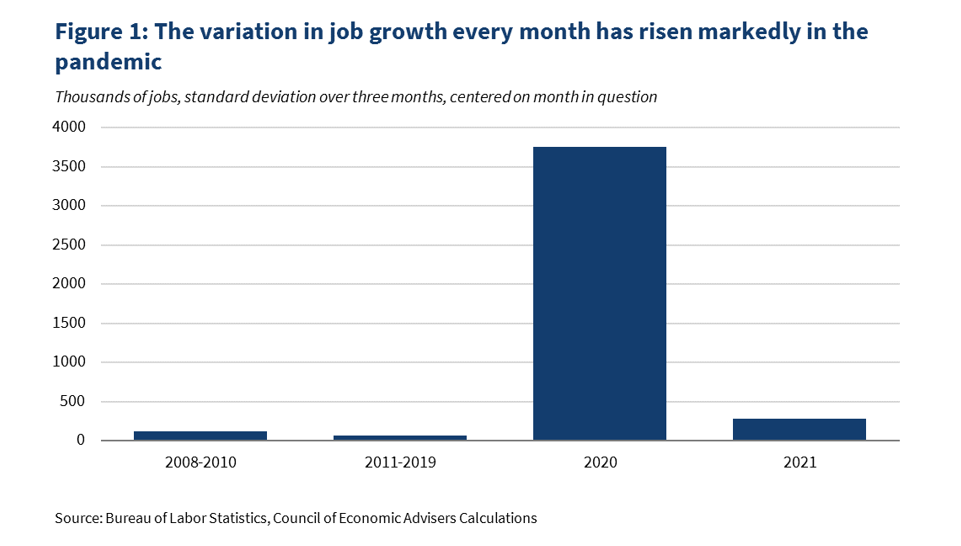
Our three-month rolling standard deviation is a different concept than the sampling error, which is what the Bureau of Labor Statistics (BLS) uses to construct its confidence intervals. However, before the pandemic, the BLS estimate of sampling error in monthly job growth was remarkably close to the average three-month standard deviation.
Using the standard deviation over three months as a proxy for a 90 percent confidence interval (as seen in Figure 2),[1] there is a wide range of what any particular one month of job growth could be.
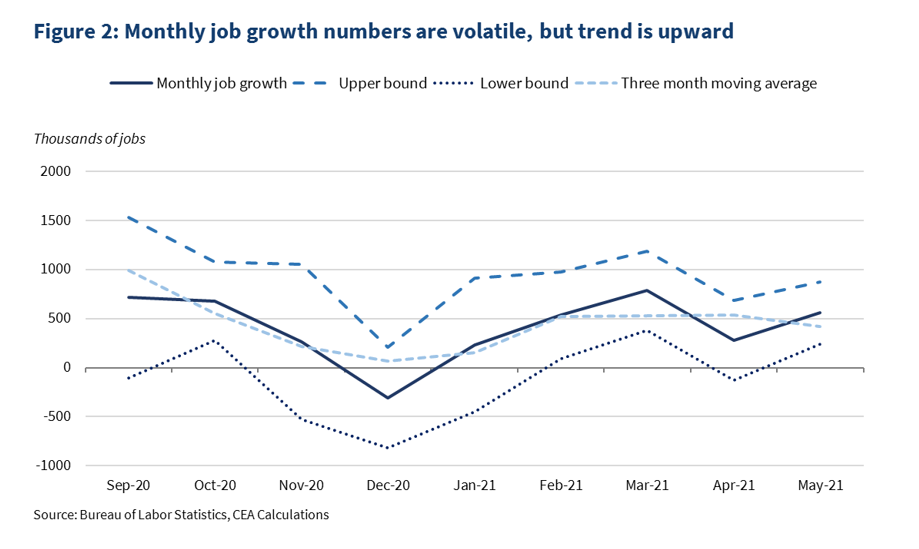
2. Changes in job growth are less persistent than before the pandemic.
Another signature of pandemic-related volatility is that job growth over one month has become less predictive of job growth in the next month, meaning there is less persistence and more uncertainty. One way to measure this is with a series of short-sample (6 months) rolling regressions, which shows the relationship between two consecutive months of jobs growth.
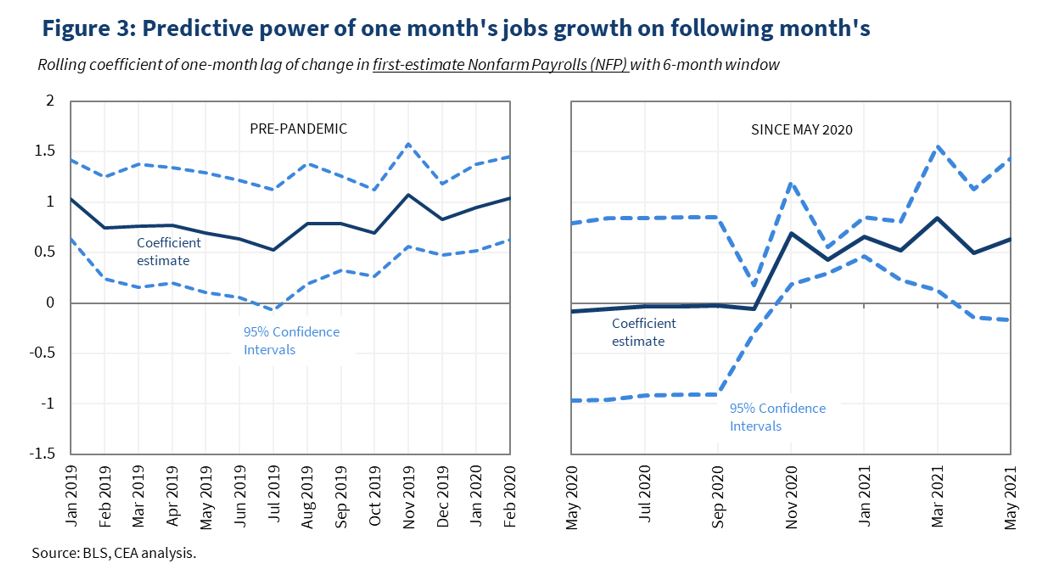
As shown in Figure 3, immediately before the pandemic, one month of job growth data was typically a strong predictor of the next month, with a coefficient estimate that was close to 1 just before the pandemic and was generally statistically–significant. Since the pandemic began, however, this predictive relationship has weakened. For much of last year, the predictive relationship was essentially zero. While the previous month’s job growth is now more predictive than it was at the start of the pandemic, it is only about half as predictive as it was just prior to the pandemic, with a coefficient of around 0.5 that is not statistically–significant. Thus, when monthly job growth has run above or below average, it is more fleeting and less persistent than what we have seen in the past. In other words, one bad or good month provides less information about the future path of job growth than it has in the past.
3. Industry-level data are sending uneven signals about the pace of economic activity.
The pandemic has not affected all industries equally. Some industries—like hotels and sit-down restaurants—have seen particularly strong declines in employment, whereas other industries—such as finance, or couriers and messengers—have been less exposed or saw above average increases in employment.
As shown in Figure 4, employment data by industry show that the economy remains in rapid transition. Two measures of the between-industry dispersion in monthly job growth—the standard deviation and interquartile range—are still higher in the latest month of economic data (May 2021) than on average over the two years before the pandemic.
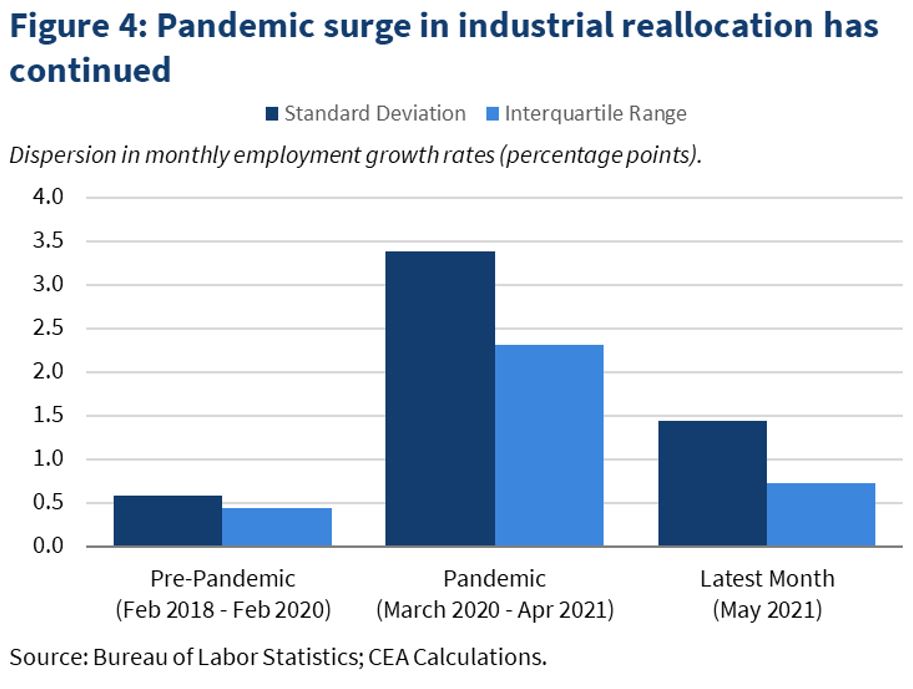
The high level of industry employment churn suggests that, as the U.S. economy reopens, swings in total employment may be more likely to reflect the reallocation of workers between industries rather than changes in broad macroeconomic conditions.
4. As in previous episodes of U.S. economic volatility, the magnitude of data revisions has been large.
It is easier to hit a still target than a moving one. Similarly, statistical agencies make larger revisions to their initial estimates of economic data in tumultuous periods, like a recession, than in calmer times.
Data from 1980 to February 2020 show that Bureau of Labor Statistics (BLS) revisions of monthly job growth are significantly larger in magnitude when BLS initial estimates of job growth have had more volatility over the preceding six months.[2]
The figure below presents the relationship between job-growth volatility and the absolute magnitude of jobs-data revisions. On the horizontal axis, we plot the standard deviation of job growth over the preceding six months, as initially reported by the Bureau of Labor Statistics. On the vertical axis, we plot the absolute revision in the monthly growth in employment. To aid visualization, we collapse the data into twenty bins and also fit a linear relationship. This “binned scatterplot” illustrates the relationship between economic volatility and the size of data revisions.
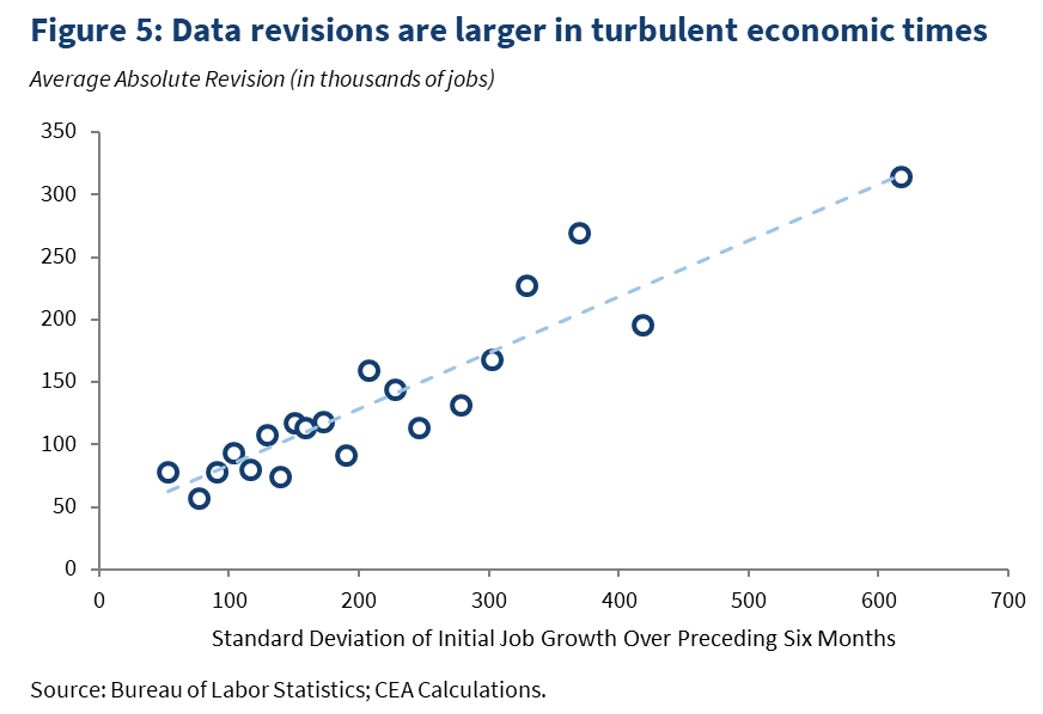
In particular, at current levels of job-growth volatility, we would expect revisions to be about twice as large in absolute magnitude than in the year before the pandemic (February 2019 to February 2020).
5. Seasonality may also contribute to volatility in the coming months.
In normal economic conditions, the U.S. labor market has significant seasonal swings in employment. For example, there is usually a surge of hiring for leisure and hospitality jobs just before the summer, which then produces a wave of layoffs and quits at the summer’s end. The BLS seasonally–adjusts the data to correct for this sort of characteristic monthly or seasonal behavior.
Amid the pandemic, however, industries may have broken their typical seasonal employment patterns and instead, may have—and continue to let—their employment decisions be guided by other factors, such as local COVID-19 prevalence and risk aversion. If these extraordinary issues swamp normal seasonal variation, seasonal adjustments may instead temporarily exacerbate volatility.
In Figure 6, we show the effect that seasonality has had on measured jobs growth so far this year, and how we think it will affect measured jobs growth for the rest of 2021. For example, between December 2020 and January 2021 there were around 2.9 million raw, unadjusted layoffs that could be explained by typical seasonal patterns, due mainly to the reversal of holiday hiring. That means that seasonally–adjusted jobs growth in January was 2.9 million higher than unadjusted growth. Our projections for July’s seasonal factor of 1.3 million tell a similar story.
In contrast, there is typically net hiring done over February to June, so seasonal factors over those months are negative. If hiring patterns in the pandemic recovery deviate from seasonal norms, then these seasonal factors could make the official seasonally–adjusted data appear more volatile month-to-month.
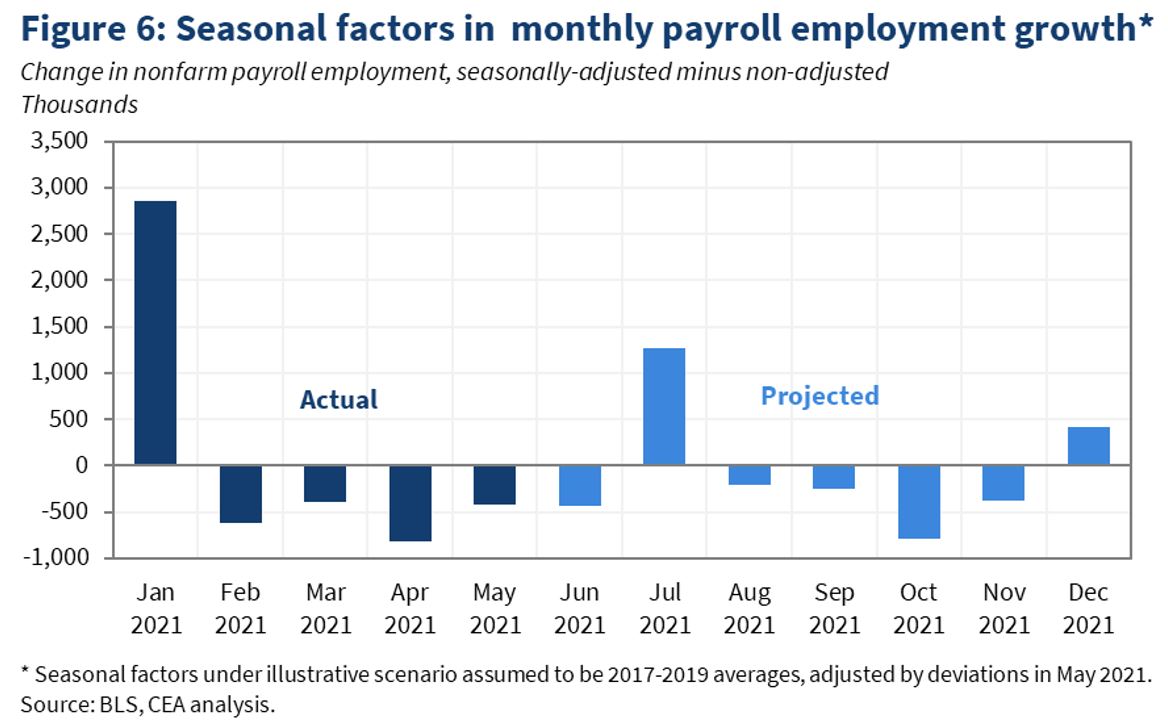
6. Increased macroeconomic volatility has challenged forecasters.
Even in a steadier economy, macroeconomic forecasting is difficult. To forecast “target” variables such as gross domestic product (GDP) or the unemployment rate, forecasters collect data on other variables that would inform the future value of the target. In a pandemic, once-stable statistical relationships between macroeconomic variables begin to break down, causing forecast models to make faulty predictions.
Figure 7 depicts the ongoing difficulty that forecasters have faced. Using data from dozens of forecasters aggregated by Bloomberg L.P, we measure forecast errors by the absolute difference between the median forecasted value and the actual value of a given data point. We further calculate a 12-month rolling average of this forecast error to illustrate how it has evolved over time.
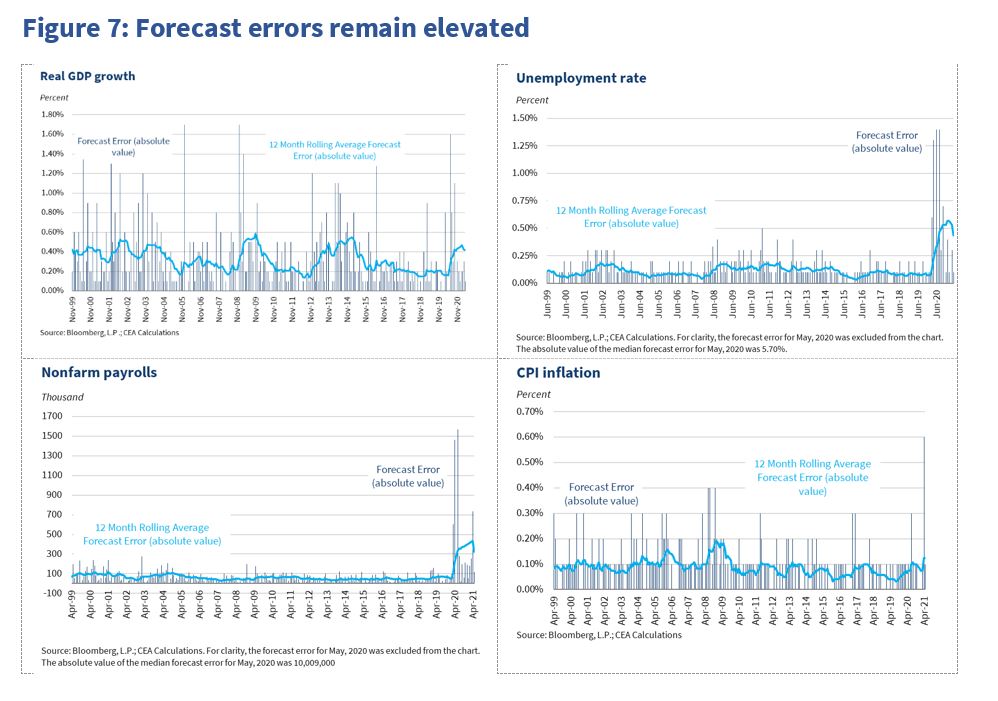
During the pandemic, forecast errors for the unemployment rate and employment growth have risen to series highs and have remained—on average—well above pre-pandemic levels. Forecast errors for real GDP rose to the higher end of their historical range, while forecast errors for inflation—as measured by changes in the Consumer Price Index—have only risen modestly, with larger errors in recent months.
Conclusion
Volatility has always been an issue in economic statistics. Veteran users of such data can recall times when data have offered confusing or misleading clues about the economy. The Council of Economic Advisers takes seriously all incoming data to offer the President its most informed assessment of economic conditions. Producing such assessments requires a careful parsing of signal from noise, making it more imperative than ever to focus on trends rather than any one specific month, and to consider data from a range of sources.
[1] The graph looks at September 2020 onward, so as to avoid scale issues when looking early in the pandemic.
[2] To account for growth in employment over this period, we compute the revisions and rolling standard deviations in log terms and then scale by payroll employment in May 2021.
